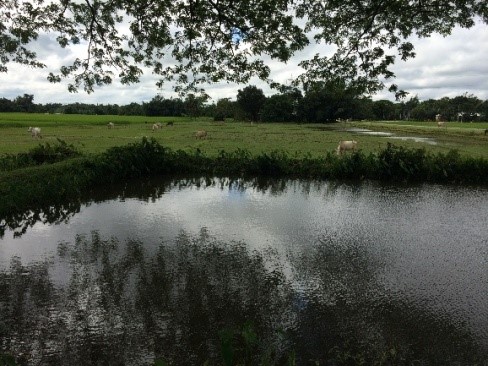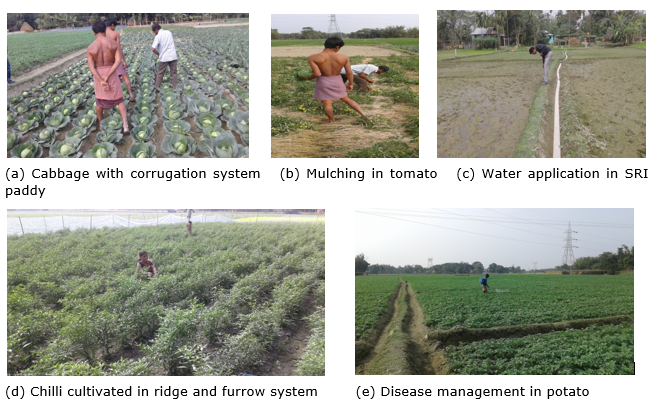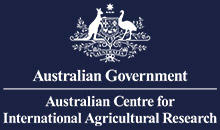Introduction:
Technical, social and economic constraints are limiting the effective use of groundwater and ponds for irrigation in many parts of the EGP. Large areas of land remain fallow during the dry months. Access to year-round water for irrigation would significantly improve the productivity of agriculture, improving incomes and food security.
Marginal and tenant farmers, youth and women are particularly vulnerable and could benefit from a new approach to irrigation provision. This project is researching and demonstrating improved collective farming systems for marginal farmers and improved water management and irrigation practices using efficient systems appropriate to the needs of the marginal farmer communities.
A project funded by the Australian Centre for International Agricultural Research (ACIAR) is working with communities across Nepal (Saptari), India (Cooch Behar and Madhubani) and North West Bangladesh, to research and demonstrate sustainable social and biophysical interventions.
Village:
The village Dhaloguri is located in the Ambari GP, Block II of the Cooch Behar district of West Bengal, India. The village is located in the sub-himalayan terai region of West Bengal. The region is characterised by high monsoonal rainfall and comparatively dry winter months. The village community is mainly dominated by the lower caste population. The average size of land holding is low with a high proportion of marginal and tenant farmers. Agriculture is the main source of livelihood for the village people. Most of the tenant farmers work as agricultural labourers. The migration of youth to other states in search of alternate livelihoods has left many families to be led by women. The village is rich in both surface and subsurface water resources. There is one perennial river called Ghargharia flowing through the village. However, most of the ponds are seasonal and only 20-25 ponds retain water throughout the year. The groundwater table is available at about 1.5 to 4.5 m below ground level. The quality of groundwater resources is appropriate for irrigation.

Fig. 1 Village Dhaloguri of Cooch Behar
Community and interventions:
At the site Jelepara site of Dhaloguri village the project is working with a collective farming group of eight members. The group members belong to the marginal and tenant population of the village. There are also two landless women farmers in the group. The village also hosts three self-help groups, one fishery cooperative and one Farmers’ Club (Alor Dishari). The collective farming group was formed by the joint effort of the project partners (UBKV, CDHI and IWMI) based on secondary social and bio-physical data collected by the project. As part of the project activities social mobilisation was done at the site through a series of community meetings, focus group discussions, community engagement programmes and gender awareness meetings.
The farmers were given technical exposure through visits to the Agricultural Fair organised at UBKV. The analysis of primary and secondary agronomical data reflected the dominance of rice based cropping system at the site. Except rain fed paddy and winter potato in some patches, most of the lands used to remain fallow during the dry season.
Irrigation infrastructure was almost non-existent. Direct pumping from a nearby river was the only source of irrigation to grow winter potato. Pumping water through very long flexible delivery pipes was highly inefficient and uneconomic as well. The physical interventions through the project started with the installation of one shallow tube well and commissioning of one 4 HP diesel pump at the site. With assured irrigation water the farmers started growing crops even during the dry seasons.
After due consideration of soil health and land situation, the project scientists proposed a wide variety of feasible crops to the farmers. They were provided technical trainings and practical demonstrations on different aspects of crop production technologies like sowing/planting, crop management, water management, and disease and pest management.
With sound technical backup the confidence of the farmers became high and consequently in the last dry season (winter of 2015-16) a total area of 10 bigha (1 ha = 7.5 bigha) was brought under winter vegetables like potato, cabbage, cauliflower, mustard, sweet potato, garlic, chilli, and tomato. The water management aspects like organic mulching in tomato, reduction in the length of furrows for potato, and corrugation irrigation to vegetables were piloted successfully at the site.
After harvesting of the winter vegetables, in the summer of 2016 the farmers are now cultivating irrigated summer rice using SRI method and jute before planting monsoonal paddy.
 |
Fig. 2 (a-e) Different crop scenarios at Site I: Jelepara of Dhaloguri
Impact:
Our research has clearly showed definite impact on the conventional agricultural practices of the farmers. Through social mobilisation and strengthening of the collective farming group the farmers have started to realise the benefits of cooperative farming. With increasing technical knowledge and scientific support the farmers are more confident to go for new crops and a more intensive cropping system. Assured supply of irrigation water has also reduced the risk of crop failure by many folds. With newly created efficient irrigation infrastructure, better water management techniques, and improved practices of crop production the overall cost of cultivation has been reduced. With higher yield and timely harvesting of the crops the market rates were more remunerative to the farmers.
Future:
It has been planned that in future emphasis will be given on strengthening the collective farming group both technically, socially and economically so that they can sustain beyond the project duration. Social trainings will be provided to the group so that they can work collectively and transparently towards the development of their livelihood status.
Technical trainings and hands-on exposure will be given to the farmers to hone their agricultural skills. Better varieties of crops, low water requiring crops (e.g. oilseeds) and high value cash crops (potato, broccoli, capsicum etc.) will be introduced in future. Special emphasis will be given to minimise the cost of production by optimum use of irrigation water.
Better designed and managed irrigation systems like ridge and furrow, bed and furrow, corrugation, level basin etc. will be introduced in future. Improvements in irrigation water conveyance, application, and distribution will ensure reduced cost of cultivation.





